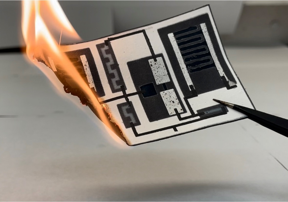Home > Press > Disposable electronics on a simple sheet of paper
 |
| An electronic circuit printed on paper could be a more flexible and disposable option for single-use electronics.
CREDIT Adapted from ACS Applied Materials & Interfaces 2022, DOI: 10.1021/acsami.2c13503 |
Abstract:
Discarded electronic devices, such as cell phones, are a fast-growing source of waste. One way to mitigate the problem could be to use components that are made with renewable resources and that are easy to dispose of responsibly. Now, researchers reporting in ACS Applied Materials & Interfaces have created a prototype circuit board that is made of a sheet paper with fully integrated electrical components, and that can be burned or left to degrade.
Disposable electronics on a simple sheet of paper
Washington, DC | Posted on October 7th, 2022
Most small electronic devices contain circuit boards that are made from glass fibers, resins and metal wiring. These boards are not easy to recycle and are relatively bulky, making them undesirable for use in point-of-care medical devices, environmental monitors or personal wearable devices. One alternative is to use paper-based circuit boards, which should be easier to dispose of, less expensive and more flexible. However, current options require specialized paper, or they simply have traditional metal circuitry components mounted onto a sheet of paper. Instead, Choi and colleagues wanted to develop circuitry that would be simple to manufacture and that had all the electronic components fully integrated into the sheet.
The team designed a paper-based amplifier-type circuit that incorporated resistors, capacitors and a transistor. They first used wax to print channels onto a sheet of paper in a simple pattern. After melting the wax so that it soaked into the paper, the team printed semi-conductive and conductive inks, which soaked into the areas not blocked by wax. Then, the researchers screen-printed additional conductive metal components and casted a gel-based electrolyte onto the sheet.
Tests confirmed that the resistor, capacitor and transistor designs performed properly. The final circuit was very flexible and thin, just like paper, even after adding the components. To demonstrate the degradability of the circuit, the team showed that the entire unit quickly burned to ash after being lit on fire. The researchers say this represents a step toward producing completely disposable electronic devices.
The authors acknowledge funding from the National Science Foundation.
####
About American Chemical Society
The American Chemical Society (ACS) is a nonprofit organization chartered by the U.S. Congress. ACS mission is to advance the broader chemistry enterprise and its practitioners for the benefit of Earth and all its people. The Society is a global leader in promoting excellence in science education and providing access to chemistry-related information and research through its multiple research solutions, peer-reviewed journals, scientific conferences, eBooks and weekly news periodical Chemical & Engineering News. ACS journals are among the most cited, most trusted and most read within the scientific literature; however, ACS itself does not conduct chemical research. As a leader in scientific information solutions, its CAS division partners with global innovators to accelerate breakthroughs by curating, connecting and analyzing the worlds scientific knowledge. ACS main offices are in Washington, D.C., and Columbus, Ohio.
To automatically receive news releases from the American Chemical Society, contact
For more information, please click here
Contacts:
ACS Newsroom
American Chemical Society
Katie Cottingham
American Chemical Society
Office: 202-236-5115
Copyright © American Chemical Society
If you have a comment, please Contact us.
Issuers of news releases, not 7th Wave, Inc. or Nanotechnology Now, are solely responsible for the accuracy of the content.
Wearable electronics
![]()
Underwater movement sensor alerts when a swimmer might be drowning October 7th, 2022
News and information
![]()
Taking salt out of the water equation October 7th, 2022
![]()
The battery that runs 630 km on a single charge October 7th, 2022
Flexible Electronics
![]()
Researchers design new inks for 3D-printable wearable bioelectronics: Potential uses include printing electronic tattoos for medical tracking applications August 19th, 2022
![]()
Fruitcake structure observed in organic polymers June 3rd, 2022
Govt.-Legislation/Regulation/Funding/Policy
![]()
Underwater movement sensor alerts when a swimmer might be drowning October 7th, 2022
![]()
NISTs superconducting hardware could scale up brain-inspired computing October 7th, 2022
Possible Futures
![]()
Underwater movement sensor alerts when a swimmer might be drowning October 7th, 2022
![]()
NISTs superconducting hardware could scale up brain-inspired computing October 7th, 2022
Chip Technology
![]()
NISTs superconducting hardware could scale up brain-inspired computing October 7th, 2022
Discoveries
![]()
Taking salt out of the water equation October 7th, 2022
![]()
The battery that runs 630 km on a single charge October 7th, 2022
Announcements
![]()
Taking salt out of the water equation October 7th, 2022
![]()
The battery that runs 630 km on a single charge October 7th, 2022
Interviews/Book Reviews/Essays/Reports/Podcasts/Journals/White papers/Posters
![]()
Taking salt out of the water equation October 7th, 2022
![]()
The battery that runs 630 km on a single charge October 7th, 2022
Printing/Lithography/Inkjet/Inks/Bio-printing/Dyes
![]()
On-Chip Photodetection: Two-dimensional material heterojunctions hetero-integration May 13th, 2022










